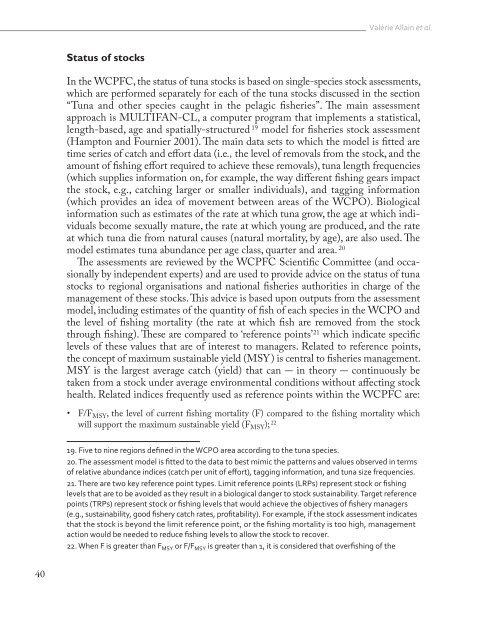Fisheries in the Pacific
Fisheries_in_the_Pacific
Fisheries_in_the_Pacific
Create successful ePaper yourself
Turn your PDF publications into a flip-book with our unique Google optimized e-Paper software.
Valérie Alla<strong>in</strong> et al.<br />
Status of stocks<br />
In <strong>the</strong> WCPFC, <strong>the</strong> status of tuna stocks is based on s<strong>in</strong>gle-species stock assessments,<br />
which are performed separately for each of <strong>the</strong> tuna stocks discussed <strong>in</strong> <strong>the</strong> section<br />
“Tuna and o<strong>the</strong>r species caught <strong>in</strong> <strong>the</strong> pelagic fisheries”. The ma<strong>in</strong> assessment<br />
approach is MULTIFAN-CL, a computer program that implements a statistical,<br />
length-based, age and spatially-structured 19 model for fisheries stock assessment<br />
(Hampton and Fournier 2001). The ma<strong>in</strong> data sets to which <strong>the</strong> model is fitted are<br />
time series of catch and effort data (i.e., <strong>the</strong> level of removals from <strong>the</strong> stock, and <strong>the</strong><br />
amount of fish<strong>in</strong>g effort required to achieve <strong>the</strong>se removals), tuna length frequencies<br />
(which supplies <strong>in</strong>formation on, for example, <strong>the</strong> way different fish<strong>in</strong>g gears impact<br />
<strong>the</strong> stock, e.g., catch<strong>in</strong>g larger or smaller <strong>in</strong>dividuals), and tagg<strong>in</strong>g <strong>in</strong>formation<br />
(which provides an idea of movement between areas of <strong>the</strong> WCPO). Biological<br />
<strong>in</strong>formation such as estimates of <strong>the</strong> rate at which tuna grow, <strong>the</strong> age at which <strong>in</strong>dividuals<br />
become sexually mature, <strong>the</strong> rate at which young are produced, and <strong>the</strong> rate<br />
at which tuna die from natural causes (natural mortality, by age), are also used. The<br />
model estimates tuna abundance per age class, quarter and area. 20<br />
The assessments are reviewed by <strong>the</strong> WCPFC Scientific Committee (and occasionally<br />
by <strong>in</strong>dependent experts) and are used to provide advice on <strong>the</strong> status of tuna<br />
stocks to regional organisations and national fisheries authorities <strong>in</strong> charge of <strong>the</strong><br />
management of <strong>the</strong>se stocks. This advice is based upon outputs from <strong>the</strong> assessment<br />
model, <strong>in</strong>clud<strong>in</strong>g estimates of <strong>the</strong> quantity of fish of each species <strong>in</strong> <strong>the</strong> WCPO and<br />
<strong>the</strong> level of fish<strong>in</strong>g mortality (<strong>the</strong> rate at which fish are removed from <strong>the</strong> stock<br />
through fish<strong>in</strong>g). These are compared to ‘reference po<strong>in</strong>ts’ 21 which <strong>in</strong>dicate specific<br />
levels of <strong>the</strong>se values that are of <strong>in</strong>terest to managers. Related to reference po<strong>in</strong>ts,<br />
<strong>the</strong> concept of maximum susta<strong>in</strong>able yield (MSY) is central to fisheries management.<br />
MSY is <strong>the</strong> largest average catch (yield) that can <strong>in</strong> <strong>the</strong>ory cont<strong>in</strong>uously be<br />
taken from a stock under average environmental conditions without affect<strong>in</strong>g stock<br />
health. Related <strong>in</strong>dices frequently used as reference po<strong>in</strong>ts with<strong>in</strong> <strong>the</strong> WCPFC are:<br />
• F/F MSY , <strong>the</strong> level of current fish<strong>in</strong>g mortality (F) compared to <strong>the</strong> fish<strong>in</strong>g mortality which<br />
will support <strong>the</strong> maximum susta<strong>in</strong>able yield (F MSY ); 22<br />
19. Five to n<strong>in</strong>e regions def<strong>in</strong>ed <strong>in</strong> <strong>the</strong> WCPO area accord<strong>in</strong>g to <strong>the</strong> tuna species.<br />
20. The assessment model is fitted to <strong>the</strong> data to best mimic <strong>the</strong> patterns and values observed <strong>in</strong> terms<br />
of relative abundance <strong>in</strong>dices (catch per unit of effort), tagg<strong>in</strong>g <strong>in</strong>formation, and tuna size frequencies.<br />
21. There are two key reference po<strong>in</strong>t types. Limit reference po<strong>in</strong>ts (LRPs) represent stock or fish<strong>in</strong>g<br />
levels that are to be avoided as <strong>the</strong>y result <strong>in</strong> a biological danger to stock susta<strong>in</strong>ability. Target reference<br />
po<strong>in</strong>ts (TRPs) represent stock or fish<strong>in</strong>g levels that would achieve <strong>the</strong> objectives of fishery managers<br />
(e.g., susta<strong>in</strong>ability, good fishery catch rates, profitability). For example, if <strong>the</strong> stock assessment <strong>in</strong>dicates<br />
that <strong>the</strong> stock is beyond <strong>the</strong> limit reference po<strong>in</strong>t, or <strong>the</strong> fish<strong>in</strong>g mortality is too high, management<br />
action would be needed to reduce fish<strong>in</strong>g levels to allow <strong>the</strong> stock to recover.<br />
22. When F is greater than F MSY or F/F MSY is greater than 1, it is considered that overfish<strong>in</strong>g of <strong>the</strong><br />
40


